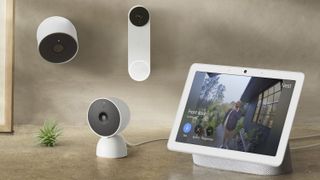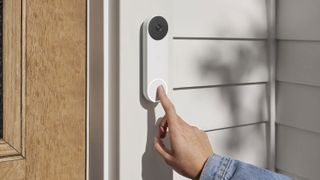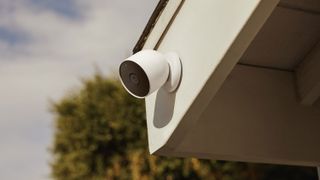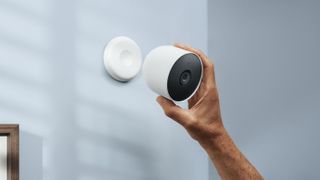Google's new Nest Cams and Doorbell keep recording even if Wi-Fi and power are out
Four new home security devices from Google

Google has announced four new smart home cameras as it moves its home security offering into its second generation.
The new product line-up includes the Nest Doorbell, Nest Cam, Nest Cam with Floodlight and the new Nest Cam Indoor.
All four feature optimized HDR, which Google claims provides better quality video both during the day and at night. The cameras (but not the Doorbell) are said to pack 2x more pixels and a 2x higher frame rate, for smoother, more detailed recordings.
The Cams and Doorbell also come with Google's new TPU chip, which allows them to track and recognize objects on-device, taking the reliance off the cloud and providing faster and more reliable tracking.
- Best video doorbell: ranking the best smart doorbell cameras
- How do video doorbells work?
- Best home security camera: the best wireless security cameras we've tested
They can even detect a wider variety of objects. Nest cameras could already recognize humans and packages, but the new devices can also recognize vehicles and animals, including their subtypes (e.g. cat, dog etc).
The improved on-device machine learning has also got better at recognizing movement that isn't worth notifying owners about - such as rain and snow, or when a car drives along the street.
All the new devices can be controlled from the newly-redesigned Google Home app on your phone, and for the battery-powered devices you'll be able to keep an eye on power levels too.
Get daily insight, inspiration and deals in your inbox
Get the hottest deals available in your inbox plus news, reviews, opinion, analysis and more from the TechRadar team.
If your Wi-Fi goes down, or your home suffers a power outage, the new Nest Doorbell, Cam and Cam with Floodlight can continue to record up to one hour's worth of footage (equivalent to around one week of events) on local storage.
Once the power/internet connection is restored, the recordings will be automatically uploaded to the cloud for you to view on your smartphone.
Who's that ringing the bell?
The Nest Doorbell is the natural successor to the Nest Hello which, unlike its predecessor, offers users the option of battery power - a first for Google's doorbell.
This means the Nest Doorbell doesn't need to be hard-wired into your property - although it can be if you prefer - with a rechargeable battery allowing for easy installation.
Google claims the Nest Doorbell battery can last around two and a half months on a single charge, based on it capturing 10-12 events a day. Battery life for the video doorbell will vary depending on climate, location and specific use cases.
The main rival to Nest Doorbell is Amazon's range of Ring devices, many of which are battery operated, so it makes sense for Google to follow suit here.

It boasts a fresh, minimalist design too, making it stand out from the Hello with its longer, flatter finish, plus it has a rainproof IP54 rating.
You can also choose the chime the Doorbell uses. It works with Google's range of Nest speakers and displays to alert you when someone has pressed the bell, but you can also connect to an existing doorbell chime if you opt for the wired installation method.
The Nest Doorbell price is $179.99 / £179.99 (around AU$240) and it's available to pre-order from August 5. It will go on-sale on August 24 in 18 countries including the US, Canada, UK, Australia and a host of European countries.
That makes Doorbell cheaper than Nest Hello ($229 / £229), which may go some way to explaining the lower resolution on offer with the former recording at 1280 x 960 and the latter is 1600 x 1200.
Look ma', no wires!

Officially titled Nest Cam (battery), this wire-free smart camera can be used both indoors and outdoors thanks to its IP54 rating that makes it rain proof.
The Nest Cam comes with a wall-mount in the box, but you can opt to purchase a table-top stand as well, which allows you to sit it on a side, which may be useful if using it indoors.
Thanks to its built-in battery pack - which can last up to three months on a single charge - there's no need to locate the camera near a power outlet, but if you want the peace of mind of continuous power the Nest Cam can also be wired to the mains.
There will be a range of accessories available for the camera in the Google Store too, including weatherproof cables of varying lengths and an anti-theft mount.
Like the Doorbell, the new Nest Cam price is $179.99 / £179.99 (around AU$240) with pre-orders live from August 5.
It will go on-sale on August 24 in 18 countries including the US, Canada, UK, Australia and a host of European countries.

Light it up
The Google Nest Cam with Floodlight is the firm's first connected floodlight. It features a centrally placed camera, with a floodlight either side of it.
Google has improved its machine learning algorithm, which it claims results in the floodlight only switching on when something important is happening - such as someone walking past the camera, but not when a car passes on the street in the background.
And finally, there's the second generation Nest Cam Indoor, which is Google's cheapest connected camera. As the name suggests, this isn't suitable for outdoor use, and there is no battery option here - instead, you'll have to find a power outlet to plug it in to.
The Nest Cam with Floodlight price will be $279.99 / £269.99 (around AU$370), while the Cam Indoor price will be $99.99 / £89.99 (around AU$130), when they go on sale later this year.
Analysis: aiming for Amazon
There's a war raging for the dominance of your smart home, and two of the biggest forces are Google and Amazon.
Both firms now offer a range of smart home products, from voice-enabled speakers and screens to doorbells, cameras, and more.
Google's latest launch may feel like a reaction to Amazon's versatile battery-powered Ring doorbells, but certainly, where the Nest Doorbell (battery) is concerned, it's addressing an issue that's been holding Google back in the video doorbell market.
Battery-operated video doorbells mean that renters and those that don't have an existing wired doorbell can still enjoy the benefits of seeing and hearing who's on the doorstep, even when they're not around. While Ring may have been first off the starting block, the likes of Eufy and Arlo have already followed suit, which had left Google lagging behind.
When it comes to the home security cameras, the addition of a battery once again means Google's offering is more flexible about where it can be installed, and hopefully appealing to a wider audience just like Ring's Stick Up Cam.
Expect to see a reaction from Amazon later this year, as it responds to Google's new devices with what could be an overhaul of its own.
Amazon has hosted a large-scale device launch event in September for the previous four years, where it usually reveals a range of Alexa-enabled devices. Chances are we'll see the same again in 2021.

John joined TechRadar over a decade ago as Staff Writer for Phones, and over the years has built up a vast knowledge of the tech industry. He's interviewed CEOs from some of the world's biggest tech firms, visited their HQs and has appeared on live TV and radio, including Sky News, BBC News, BBC World News, Al Jazeera, LBC and BBC Radio 4. Originally specializing in phones, tablets and wearables, John is now TechRadar's resident automotive expert, reviewing the latest and greatest EVs and PHEVs on the market. John also looks after the day-to-day running of the site.
